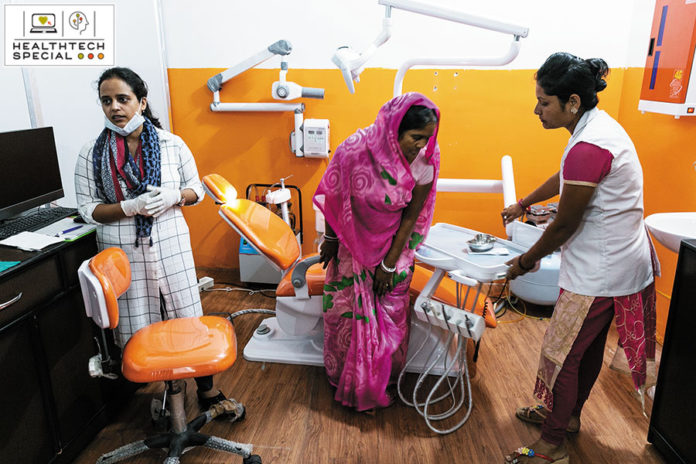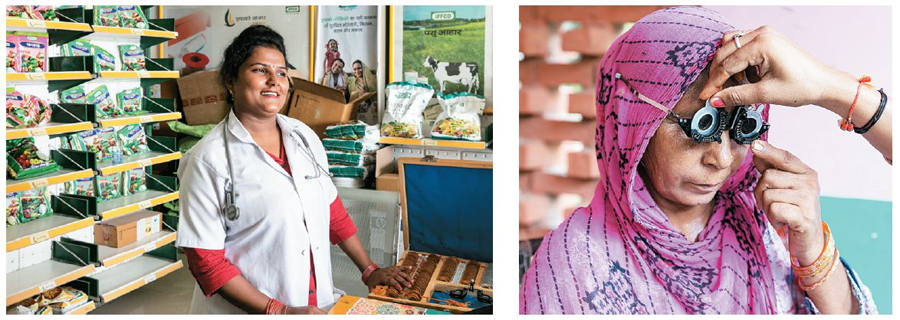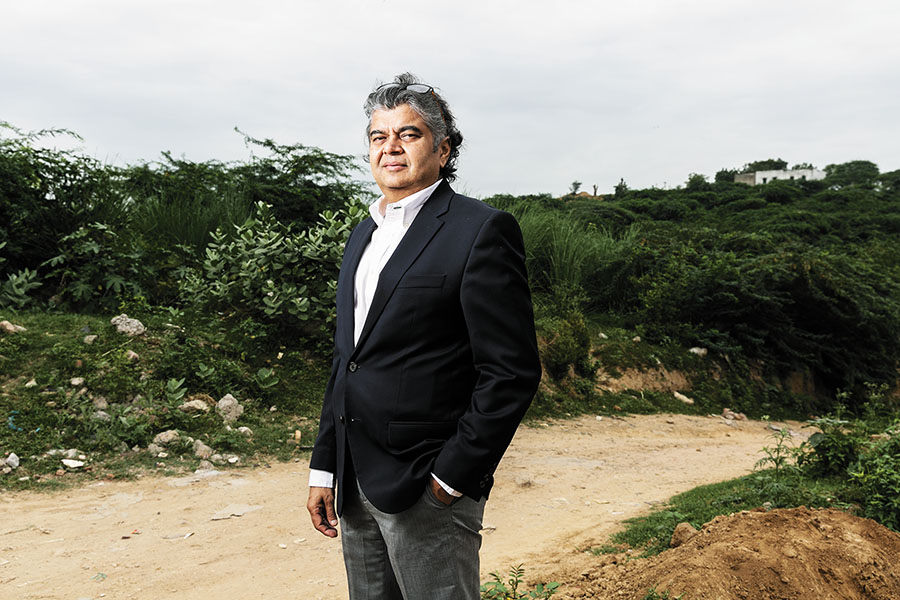
A combination of telemedicine and on-the-ground presence, along with an asset-light model, are helping Gramin Healthcare scale its primary health care model in rural areas
On a hot, humid August day in Nalvi Kalan village in Haryana’s Karnal district, a portion of a primary school is being used for a health camp. For two days before this, Seema, a nurse who is now checking a woman’s eyesight using charts suitable for the unschooled, went around the village with a megaphone, announcing the camp. Announcements were also made at the school so that children could tell their parents about it; today women and men, children in tow, are lining up to register for a health card that will give them access to primary health care all year round. A doctor and two nurses conduct various basic tests, including blood pressure, ECG and vision. Villagers can also buy ayurvedic medicines and prescription glasses at the camp.
A camp like this is the last mile in Gramin Healthcare’s model of providing primary health care in rural India which, since it was started in September 2015, has set up 110 primary health care centres in six states; one centre is for a cluster of ten villages or so. These aim to provide villagers, who would otherwise go to a local medicine man or travel to the nearest town, with institutionalised health care closer home. Twice a week, the staff head out to individual villages to hold camps, while also maintaining digital health records of all the card holders.
“People in villages have to travel to hospitals or clinics, which not only costs them money but also a day or half a day of work. It’s worse for women who depend on their husbands to take them to the doctor. This way, the women can come over themselves. The camp also makes it easier for senior citizens,” says Sonia Vohra, head of operations, Gramin Healthcare.
A few kilometres away, in the compound of a Skill Development Centre, is a space rented by Gramin for a centre where a nurse is on hand and can do about 30 tests. For further consultation and prescriptions, she is equipped with a tablet that she uses to connect via an audio or video call with a doctor from the Gramin team based in Gurugram. It is where Rajni, 32, who is among the women learning embroidery and stitching at the centre and where a camp specifically for women was held a month ago, registered for a card. Her husband, a rickshaw driver, has hernia. Since registering, she has brought her children and him to the centre a couple of times.

Image: Madhu Kapparath
The card currently costs ₹120 (with ₹100 often sponsored) and entitles a family of four to check-ups and consultations for a year. Though the card was launched only in August last year, Gramin founder Ajoy Khandheria says he was clear from the beginning that it would be a paid-for model, not just to be able to scale but also to ensure it’s not charity. “I think non-profit organisations do not scale up and if you scale up, somebody questions if it is really non-profit. I’m saying I’m a for-profit organisation. Therefore, if I am doing this correctly, if I am able to make money, I will be able to scale up. I don’t need charity to grow; I am growing and the people I’m serving are not being served on charity, they are being served on merit,” says Khandheria, 57, who has over 25 years of experience in building telecom, telematics, and health care businesses. He launched Gramin after hearing “horror” stories from people in fertiliser cooperative IFFCO, with which it has partnered to set up the centres.
While there are a few standalones like the one at the Skill Development Centre, most of Gramin’s centres are in IFFCO Bazaars that the cooperative started setting up in 2016 to take fertilisers and education about farming processes to farmers. “We always wanted to provide health care facilities to all our stakeholders. Our association with Gramin Healthcare started about two years ago. We started with telemedicine, mobile vans, etc. Once we started rolling out our IFFCO Bazaars, we decided to offer a shop-in-shop health care clinic to our stakeholders, the farmers of India,” says Manish Gupta, director (strategy and joint ventures), IFFCO, which also picked up a 26 percent stake in Gramin last April.
Nurse Sunita has been working at the IFFCO Bazaar in Nigdhu for about a year and a half. “People come in with complaints of joint pain, fever, blood pressure,” says Sunita, recollecting how a farmer with extreme pain was referred to a hospital.
The company has also partnered with nearby hospitals where a card holder can get a 40-60 percent discount, says Vohra. The idea is to keep the model asset and capital light and focus on building primary care to the level of secondary. “We believe we can make a modest profit with scale, with deeper penetration,” says Khandheria. Besides cards and partnerships with hospitals, other revenue streams include sale of medicines, spectacles and services at subsidised rates. On the cards is a partnership with manufacturers of biodegradable sanitary pads.

Image: Madhu Kapparath
G“I don’t think people have a clue about the extent of the issue when it comes to primary care in rural India. A study by World Bank economist Jishnu Das revealed some shocking figures—80 percent-plus practitioners of primary health care in rural India don’t have any kind of medical-related qualifications,” says Muralidharan M Nair, health care advisory, EY India, while stressing on the need for trained professionals and the government to take the lead. “The right-skilled persons need to be supplemented by technological tools like artificial intelligence and cost-effective diagnostics as well as access to specialist advice.” Another challenge, says Nair, “Is how do you get people to work there? That is also where you will have to innovate and create.”
Taking the centre’s model forward, Gramin is now also setting up polyclinics, aiming for one for every 10 centres; besides consultation with doctors, they will also offer dental and physiotherapy services as well as a pharmacy and day care facilities. “Secondary (care) onwards there will be other people who will do that. But in primary care I will do everything—vision, dental, physio, pain management. If somebody has a slip disc in a village, he requires pain management, he requires physio. Every human being requires a dentist. And you don’t have high quality facilities available for this. We will provide that in the clinics,” says Khandheria.
The first of its clinics in rural areas (there is one at its office in Gurugram that serves delivery boys and other staff), in Karnal town, is a cheery space with orange and grey walls and state-of-the-art facilities. Polyclinics also help address the manpower challenge. “Every aspiring health care professional wants to work in a city… working in primary care is not career-enhancing. So we decided for every 10 primary centres we will have a polyclinic. It will be larger, fancier, and a place where doctors and other health care professionals are happy to be working. These are lessons we have learnt over time and are modifying the model,” says Khandheria who started Gramin with his own funds, an investment of about ₹1.5 crore.
Though there are others like Rajasthan-based Karma Healthcare working in the space, IFFCO’s local presence and influence have helped Gramin scale. Gramin reported a revenue of ₹1 crore in 2017-2018 and is looking at ₹5 crore for 2018-2019.
“We always wanted to provide health care facilities to all our stakeholders (farmers).”
Manish Gupta, director (strategy and joint ventures), IFFCO
It is also in talks to employ its model for truck drivers at petrol pumps. “Many of the truckers probably have more problems… they have a posture that gets damaged because they are driving 12 hours a day. But they cannot take time out to go to a doctor because they need to be at a particular place at a particular time. So if we can be there for them and if we can help them out there it works out well. So a lot of innovation from being on the ground and learning,” says Khandheria. Their physical presence in villages through the camps means they can also create awareness about the Ayushman Bharat scheme announced by the government recently.
“With the emergence of non-communicable diseases and chronic ones, there is a growing need for care for these kind of illnessess. The model increases the outreach of medical services using nurses as the point of contact. With the India situation—few doctors and a larger population—and doctors unwilling to go to rural areas, this is a reasonable model,” says Dr Abhay Bang, who works in the field of community health in the villages of Gadchiroli, adding that patient uptake is key.
With a team of 15-20 doctors and 110-plus nurses, Gramin has grown to 250,000 unique patients a year and is looking to get to about 5 million unique patients a year in three years. Considering the target audience for primary health care in India is about 700 million people, 5 million, says Khandheria, is not a big number. “If there are ten companies doing it, we have addressed 50 million. We are nowhere. Five million sounds like a huge number but it is less than one percent of the target audience. And which successful businessperson can be considered successful with one percent market share?”
(This story appears in the 28 September, 2018 issue of Forbes India. You can buy our tablet version from Magzter.com. To visit our Archives, click here.)
Reference Link:
http://www.forbesindia.com/article/healthtech-special/gramin-healthcare-what-the-doctor-ordered/51307/1








